Do you have a question about the Haier AS50XCAHRA and is the answer not in the manual?
Explains the model name structure for AS50XCAHRA.
Covers installation wiring, repair cautions, post-repair advice, inspection steps, and icon usage.
Overviews the main operational modes and control logic.
Explains how the system automatically selects modes based on temperature.
Details the temperature control and airflow speed for cooling.
Explains the temperature control and operation for dehumidifying.
Details temperature control, fan speeds, and cold air proofing in heating.
Describes the 'strength' operation mode and its activation.
Explains the 'mute' operation mode for reduced noise.
Describes the air refreshing function, noting it's not applicable to this model.
Details the 24-hour on/off timing functions.
Explains the 8-hour dormant operation mode and its temperature adjustments.
Describes the function of the urgency button for immediate operation or testing.
Explains the protection mechanism against low load conditions.
Details the protection mechanism against high load conditions.
Describes malfunctions due to mismatched indoor/outdoor system modes.
Explains how the malfunction list is displayed and reset.
Methods for confirming abnormalities like sensor failures.
Warnings before performing diagnostic procedures.
Lists common symptoms and their corresponding check items and measures.
Lists error codes and their descriptions for indoor and outdoor units.
Details thermistor failures, causes, and troubleshooting steps.
Describes EEPROM errors, causes, and troubleshooting.
Explains indoor fan motor failures, causes, and checks.
Details outdoor fan motor faults, causes, and troubleshooting.
Describes IPM protection issues, causes, and troubleshooting.
Details compressor over-current issues, causes, and troubleshooting.
Explains communication faults between IPM and outdoor PCB.
Describes power supply voltage issues and troubleshooting.
Explains overheat protection related to discharge temperature.
Details communication faults between indoor and outdoor units.
Describes issues with inverter side current detection and synchronism.
Explains high work-intense protection in heating mode.
Provides the wiring diagram for the indoor unit.
Shows the detailed circuit diagrams for the unit.
Step-by-step guide to remove the front panel of the indoor unit.
Instructions for removing air filters and the horizontal flap.
Steps to remove the fan motor and fan assembly.
Steps to remove the fan motor and fan.
Instructions for removing the main casing of the unit.
Steps to disconnect stepping motor wires and remove the control box.
Procedure for removing the heat exchanger.
Explains the model name structure for AS50XCAHRA.
Covers installation wiring, repair cautions, post-repair advice, inspection steps, and icon usage.
Overviews the main operational modes and control logic.
Explains how the system automatically selects modes based on temperature.
Details the temperature control and airflow speed for cooling.
Explains the temperature control and operation for dehumidifying.
Details temperature control, fan speeds, and cold air proofing in heating.
Describes the 'strength' operation mode and its activation.
Explains the 'mute' operation mode for reduced noise.
Describes the air refreshing function, noting it's not applicable to this model.
Details the 24-hour on/off timing functions.
Explains the 8-hour dormant operation mode and its temperature adjustments.
Describes the function of the urgency button for immediate operation or testing.
Explains the protection mechanism against low load conditions.
Details the protection mechanism against high load conditions.
Describes malfunctions due to mismatched indoor/outdoor system modes.
Explains how the malfunction list is displayed and reset.
Methods for confirming abnormalities like sensor failures.
Warnings before performing diagnostic procedures.
Lists common symptoms and their corresponding check items and measures.
Lists error codes and their descriptions for indoor and outdoor units.
Details thermistor failures, causes, and troubleshooting steps.
Describes EEPROM errors, causes, and troubleshooting.
Explains indoor fan motor failures, causes, and checks.
Details outdoor fan motor faults, causes, and troubleshooting.
Describes IPM protection issues, causes, and troubleshooting.
Details compressor over-current issues, causes, and troubleshooting.
Explains communication faults between IPM and outdoor PCB.
Describes power supply voltage issues and troubleshooting.
Explains overheat protection related to discharge temperature.
Details communication faults between indoor and outdoor units.
Describes issues with inverter side current detection and synchronism.
Explains high work-intense protection in heating mode.
Provides the wiring diagram for the indoor unit.
Shows the detailed circuit diagrams for the unit.
Step-by-step guide to remove the front panel of the indoor unit.
Instructions for removing air filters and the horizontal flap.
Steps to remove the fan motor and fan assembly.
Steps to remove the fan motor and fan.
Instructions for removing the main casing of the unit.
Steps to disconnect stepping motor wires and remove the control box.
Procedure for removing the heat exchanger.
| Type | Inverter |
|---|---|
| Cooling Capacity | 5.0 kW |
| Refrigerant | R32 |
| Power Supply | 220-240V, 50Hz |
| Operating Temperature (Cooling) | 18-43 °C |

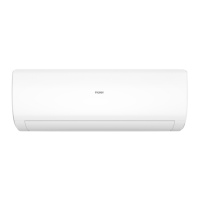
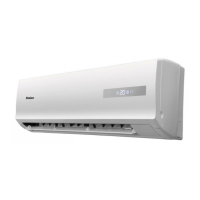
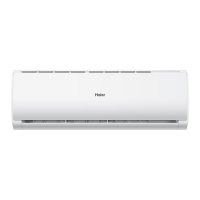
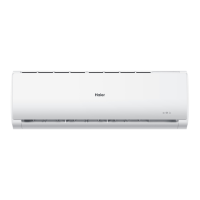
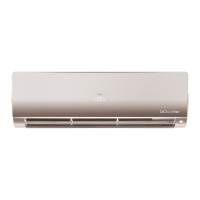



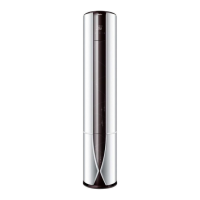

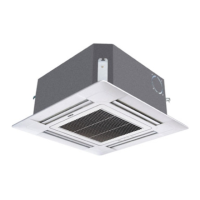
